Parkside PFBS 9.6 A1 User Manual [cs, en, de]
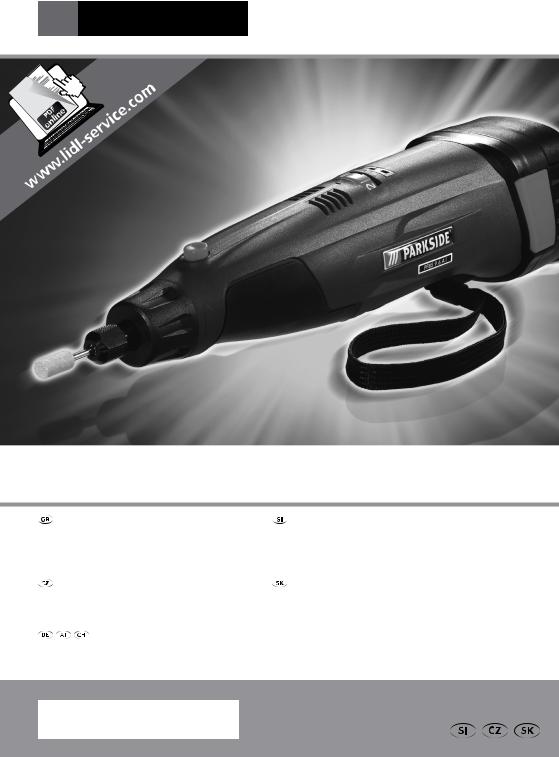
CORDLESS MULTIGRINDER PFBS 9.6 A1
CORDLESS MULTIGRINDER |
AKUMULATORSKI BRUSILNIK IN |
|||
Operation and Safety Notes |
VRTALNIK ZA FINOMEHANIKO |
|||
Translation |
of original operation manual |
Navodila za upravljanje in varnostna opozorila |
||
|
|
|
Prevod originalnega navodila za uporabo |
|
AKU VRTACÍ BRUSKA |
AKUMULÁTOROVÁ JEMNÁ VŔTACIA BRÚSKA |
|||
Pokyny pro obsluhu a bezpečnostní pokyny |
Pokyny pre obsluhu a bezpečnostné pokyny |
|||
Překlad |
originálního provozního návodu |
Preklad |
originálneho návodu na obsluhu |
|
AKKU-FEINBOHRSCHLEIFER
Bedienungs - und Sicherheitshinweise
Originalbetriebsanleitung
IAN 90550
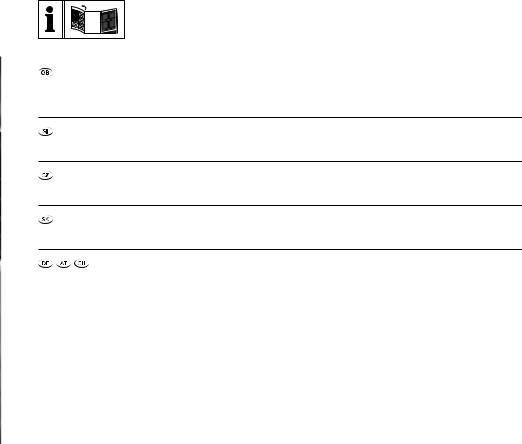
Before reading, unfold the page containing the illustrations and familiarise yourself with all functions of the device.
Pred branjem odprite stran s slikami in se nato seznanite z vsemi funkcijami naprave.
Před čtením si otevřete stranu s obrázky a potom se seznamte se všemi funkcemi přístroje.
Pred čítaním si odklopte stranu s obrázkami a potom sa oboznámte so všetkými funkciami prístroja.
Klappen Sie vor dem Lesen die Seite mit den Abbildungen aus und machen Sie sich anschließend mit allen Funktionen des Gerätes vertraut.
GB |
Operation and Safety Notes |
Page |
5 |
SI |
Navodila za upravljanje in varnostna opozorila |
stran |
19 |
CZ |
Pokyny pro obsluhu a bezpečnostní pokyny |
strana |
33 |
SK |
Pokyny pre obsluhu a bezpečnostné pokyny |
strana |
45 |
DE / AT / CH |
Bedienungsund Sicherheitshinweise |
seite |
59 |
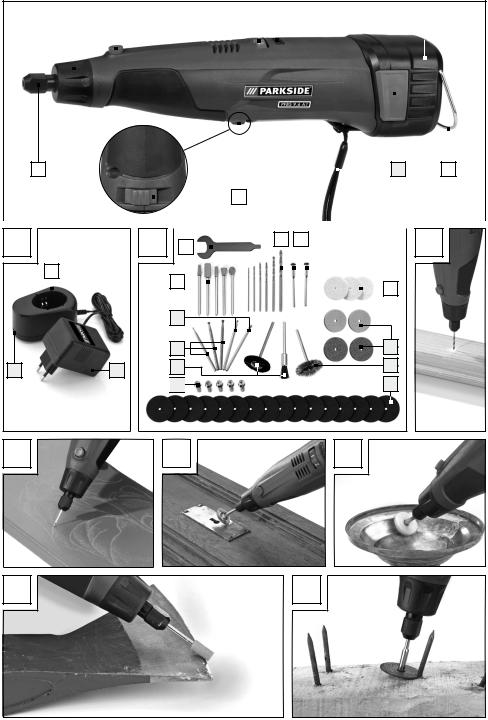
7 |
|
8 |
|
1 |
|
2 |
|
3 |
|
3a |
||||||
|
|
|
|
|
|
|
|
|
|
|
|
|
|
|
|
|
|
|
|
|
|
|
|
|
|
|
|
|
|
|
|
|
|
|
|
|
|
|
|
|
|
|
|
|
|
|
|
|
|
|
|
|
|
|
|
|
|
|
|
|
|
|
|
|
|
|
|
|
|
|
|
|
|
|
|
|
|
|
|
|
|
|
|
|
|
|
|
|
|
|
|
|
|
|
|
|
|
|
|
|
|
|
|
|
|
|
|
|
|
|
|
|
|
|
|
|
|
|
|
|
|
|
|
|
|
|
|
|
|
|
|
|
|
|
|
|
|
|
|
|
|
|
|
|
|
|
|
|
|
|
|
6 |
|
|
|
|
|
|
|
|
|
|
|
|
|
|
|
|
|
|
|
|
|
|
|
4a |
|
4 |
|
||||
|
|
|
|
|
|
|
|
|
|
|
|
|
|
|
|
|
|
|
|
|
|
|
|
|
|
|||||||
|
|
|
|
|
|
|
|
|
|
|
|
|
|
|
|
|
|
|
|
|
|
|
|
|
|
|
|
|
|
|
|
|
|
|
|
|
|
|
|
|
|
|
|
|
|
5 |
|
|
|
|
|
|
|
|
|
|
|
|
|
|
|
|
|
|
|
|
|
|
|
|
|
|
|
|
|
|
|
|
|
|
|
|
|
|
|
|
|
|
|
|
|
|
|
|||||
|
|
|
|
|
|
|
|
|
|
|
|
|
|
|
|
|
|
|
|
|
|
|
|
|
|
|
|
|
|
|
|
|
A |
|
|
|
B |
|
|
|
|
|
|
|
|
|
|
|
|
|
|
|
|
|
|
|
|
|
|
|
|
||||
|
|
|
23 |
|
|
|
|
|
|
|
|
|
|
|
|
|
|
|
|
|
|
C |
|
|
|
|||||||
|
|
|
|
|
|
|
|
|
12 |
|
13 |
|
|
|
|
|
|
|
|
|
|
|||||||||||
|
|
|
|
|
|
|
|
|
|
|
|
|
|
|
|
|
|
|
|
|
|
|
|
|
|
|
|
|
||||
|
|
|
|
|
|
|
|
|
|
|
|
|
|
|
|
|
|
|
|
|
|
|
|
|
|
|
|
|
|
|
|
|
|
|
|
|
|
|
|
|
|
|
|
|
|
|
|
|
|
|
|
|
|
|
|
|
|
|
|
|
|
|
|
|
|
|
|
9 |
|
|
|
|
|
|
|
|
|
|
|
|
|
|
|
|
|
|
|
|
|
|
|
|
|
|
|
|
|
|
|
|
|
|
22 |
|
|
|
|
|
|
|
|
|
|
|
|
|
|
|
|
|
|
|
|
|
|
|
|
||||
|
|
|
|
|
|
|
|
|
|
|
|
|
|
|
|
|
|
|
|
|
14 |
|
|
|
|
|
|
|
||||
|
|
|
|
|
|
|
|
|
|
|
|
|
|
|
|
|
|
|
|
|
|
|
|
|
|
|
|
|||||
|
|
|
|
|
|
|
|
|
|
|
|
|
|
|
|
|
|
|
|
|
|
|
|
|
|
|
|
|
|
|
||
21
|
|
20 |
15 |
11 |
10 |
19 |
16 |
|
|
||
|
|
18 |
17 |
D |
E |
F |
G |
H |

Table of contents
Introduction |
|
|
Proper use............................................................................................................................................ |
Page |
6 |
Features and equipment...................................................................................................................... |
Page |
6 |
Included items...................................................................................................................................... |
Page |
6 |
Technical information.......................................................................................................................... |
Page |
6 |
General safety advice for electrical power tools |
|
|
1. Workplace safety............................................................................................................................ |
Page |
7 |
2. Electrical safety............................................................................................................................... |
Page |
7 |
3. Personal safety................................................................................................................................ |
Page |
8 |
4. Careful handling and use of electrical power tools...................................................................... |
Page |
8 |
5. Use and handling of the cordless electrical power tool............................................................... |
Page |
9 |
6. Service............................................................................................................................................. |
Page |
9 |
Safety advice for all uses.................................................................................................................... |
Page |
9 |
Safety advice relating to kickback...................................................................................................... |
Page 10 |
|
Special safety advice relating to grinding and disc-cutting.............................................................. |
Page 11 |
|
Further special safety advice for disc-cutting..................................................................................... |
Page 11 |
|
Special safety advice for abrading using sandpaper....................................................................... |
Page 12 |
|
Special safety advice for polishing..................................................................................................... |
Page 12 |
|
Special safety advice for working with wire brushes........................................................................ |
Page 12 |
|
Safety advice applicable specifically to cordless multigrinders....................................................... |
Page 12 |
|
Operation |
|
|
Charging the battery pack.................................................................................................................. |
Page 13 |
|
Inserting / removing the battery pack into / out of the drill / grinder................................................ |
Page |
13 |
Reading off the battery status............................................................................................................. |
Page 13 |
|
Inserting or replacing a tool / collet.................................................................................................... |
Page 14 |
|
Switching on and off / Setting the speed range................................................................................ |
Page 14 |
|
Advice on working with materials / Tools / Speed ranges................................................................ |
Page 14 |
|
Tips and tricks...................................................................................................................................... |
Page 15 |
|
Maintenance and cleaning |
|
|
Maintenance........................................................................................................................................ |
Page 15 |
|
Cleaning............................................................................................................................................... |
Page 15 |
|
Service................................................................................................................................................ |
Page 15 |
|
Warranty......................................................................................................................................... |
Page 15 |
|
Disposal............................................................................................................................................. |
Page 16 |
|
Declaration of conformity / Manufacturer........................................................... |
Page 17 |
|
GB 5

Introduction
Cordless multigrinder PFBS 9.6 A1
Q Introduction
We congratulate you on the purchase of your new device. You have chosen a high quality product. The instructions for use are part of the product. They contain important information concerning safety, use and disposal. Before using the product, please familiarise yourself with all of the safety information and instructions for use. Only use the unit as described and for the specified applications. If you pass the product on to anyone else, please ensure that you also pass on all the documentation with it.
Q Proper use
The rechargeable precision rotary tool with the corresponding accessory (as supplied) is intended to be used for drilling, milling, engraving, polishing, cleaning, grinding, cutting and sawing materials such as wood, metal, plastic, ceramics or stone in dry environments. Any other use or modification to the drill / grinder shall be considered as improper use and could give rise to considerable dangers. The manufacturer will not accept liability for loss or damage arising from improper use. Not intended for commercial use.
Q Features and equipment
Cordless multigrinder:
1Rotational speed control
2Battery-operated LED
3Battery pack release button 3a Battery pack
4Metal stirrup hanger
4a Wrist strap
5On / Off switch
6Clamping nut
7Spigot nut
8Spindle lock
Battery charger (see Fig. A):
9 Charging cradle
10Mains adapter
11LED
Accessories (see Fig. B):
126 HSS drills
132 Mandrels for mounting tools
143 Polishing wheels
154 Grinding wheels
161 Metal brush
1716 Cutting wheels
185 Collets
192 Plastic brushes
203 Engraving bits
212 Milling bits
225 Grinding bits
23Combination tool
Q Included items
1 Cordless multigrinder with rechargeable battery pack
1 Charging cradle
1 Mains adapter
1 Accessory kit (50-piece)
1 Operating instructions
Q Technical information
Model PFBS 9.6 A1:
Rated voltage: |
9.6 V |
Rated speed: |
n 5000–25000 min-1 |
Max. disc ø: |
25 mm |
Collet capacity: |
max. ø 3.2 mm |
Rechargeable battery pack PFBS 9.6 A1-1:
Rated voltage: |
9.6 V |
Capacity: |
1000 mAh NiMH |
Battery charger PFBS 9.6 A1-2: |
|
Primary: |
|
Rated voltage: |
230–240 V , 50 Hz |
Rated input: |
13 W |
6 GB

Introduction / General safety advice for electrical power tools
Secondary: |
|
Rated voltage: |
12 V |
Charging current: |
400 mA |
Charging duration: |
approx. 3 hours |
Protection class: |
II / |
Noise and vibration data:
Measured values for noise are determined in accordance with EN 60745. The A-weighted noise level of the electrical power tool are typically:
Sound pressure level: |
70.4 dB(A) |
Sound power level: |
81.4 dB(A) |
Uncertainty K: |
3 dB |
Wear ear protection!
Evaluated acceleration, typical:
Hand / arm vibration: 0.759 m / s2 Uncertainty K = 1.5 m / s2

 The vibration level specified in these instructions was measured in accordance with an EN 60745 standardised measurement process and can be used to compare equipment. The vibration emission value specified can also serve as a preliminary assessment of the exposure.
The vibration level specified in these instructions was measured in accordance with an EN 60745 standardised measurement process and can be used to compare equipment. The vibration emission value specified can also serve as a preliminary assessment of the exposure.
The vibration level will change according to the application of the electrical tool an in some cases may exceed the value specified in these instructions. Regularly using the electric tool in such a way may make it easy to underestimate the vibration.
Note: If you wish to make an accurate assessment of the vibration loads experienced during a particular period of working, you should also take into account the intervening periods of time when the device is switched off or is running but is not actually in use. This can result in a much lower vibration load over the whole of the period of working.
QGeneral safety advice for electrical power tools

 Read all the safety advice and instructions!
Read all the safety advice and instructions!
Failure to observe the safety advice and instructions may result in electric shock, fire and / or serious injury.
Keep all the safety advice and instructions in a safe place for future reference!
The term “electrical tool” used in the safety advice refers to electrical tools powered by mains electricity (by means of a mains lead) and electrical tools powered by rechargeable batteries (without a mains lead).
1. Workplace safety
a)Keep your working area clean and well lit. Untidy or poorly lit working areas can lead to accidents.
b)Do not work with the device in potentially explosive environments in which there are inflammable liquids, gases or dusts. Electrical power tools create sparks, which can ignite dusts or fumes.
c)Keep children and other people away while you are operating the electrical tool. Distractions can cause you to lose control of the device.
2. Electrical safety
a)The mains plug on the power tool (or on the power supply) must fit the mains socket. Never modify the plug in any way. Never use adapter plugs with earthed power tools. Unmodified plugs and the correct sockets reduce the risk of electric shock.
b)Avoid touching earthed surfaces such as pipes, radiators, ovens and refrigerators with any part of your body.
There is an increased risk of electric shock if your body is earthed.
GB 7

General safety advice for electrical power tools
c)Keep the device away from rain or moisture. Water entering an electrical device increases the risk of electric shock.
d)Do not use the mains lead for any purpose for which it was not intended, e.g. to carry the device, to hang up the device or to pull the mains plug out of the mains socket. Keep the mains lead away from heat, oil, sharp edges or moving parts of the device. Damaged or tangled mains leads increase the risk of electric shock.
e)When working outdoors with an electrical power tool always use extension cables that are also approved for use outdoors. The use of an extension cable suitable for outdoor use reduces the risk of electric shock.
f)Use a residual current device (RCD) for protection if operating the electrical power tool in a moist environment is unavoidable. The use of an RCD reduces the risk of electric shock.
3. Personal safety
a)Remain alert at all times, watch what you are doing and always proceed with caution. Do not use the device if you are tired or under the influence of drugs, alcohol or medication. One moment of carelessness when using the device can lead to serious injury.
b)Wear personal protective equipment and always wear safety glasses. The wearing of personal protective equipment such as dust masks, non-slip safety shoes, safety helmets or ear protectors, appropriate to the type of electrical power tool used and work undertaken, reduces the risk of injury.
c)Avoid accidental starting. Verify the power tool is switched off before connecting it to the mains and / or connecting the battery, picking it up, or carrying it.
Accidents can happen if you carry the device with your finger on the ON / OFF switch or with the device switched on.
8 GB
d)Remove any setting tools or spanners before you switch the device on. A tool or spanner left attached to a rotating part of a device can lead to injury.
e)Avoid placing your body in an unnatural position. Keep proper footing and balance at all times. By doing this you will be in a better position to control the device in unforeseen circumstances.
f)Wear suitable clothing. Do not wear loose clothing or jewellery. Keep your hair, clothing and gloves clear of moving parts. Loose clothing, jewellery or long hair can become trapped in moving parts.
g)If vacuum dust extraction and collection devices are fitted do not forget to check that they are properly connected and correctly used. The use of these devices reduces the hazard presented by dust.
4.Careful handling and use of electrical power tools
a)Do not overload the device. Always use an electrical power tool that is intended for the task you are undertaking. By using the right electrical power tool for the job you will work more safely and achieve a better result.
b)Do not use an electrical power tool if its switch is defective. An electrical power tool that can no longer be switched on and off is dangerous and must be repaired.
c)Pull the mains plug out of the socket and / or remove the rechargeable battery before you make any adjustments to the device, change accessories or when the device is put away. This precaution is intended to prevent the device from unintentionally starting.
d)When not in use always ensure that electrical power tools are kept out of reach of children. Do not let anyone use the device if he or she is not familiar with it or has not read the instructions and advice. Electrical power tools are dan-

General safety advice for electrical power tools
gerous when they are used by inexperienced people.
e)Look after the device carefully. Check that moving parts are working properly and move freely. Check for any parts that are broken or damaged enough to detrimentally affect the functioning of the device. Have damaged parts repaired before you use the device. Many accidents have their origins in poorly maintained electrical power tools.
f)Keep cutting tools clean and sharp.
Carefully maintained cutting tools with sharp cutting edges are less likely to jam and are easier to control.
g)Use the electrical power tool, accessories, inserted tools etc. in accordance with these instructions and advice, and the stipulations drawn up for this particular type of device. In doing this, take into account the working conditions and the task in hand. The use of electrical power tools for purposes other than those intended can lead to dangerous situations.
5.Use and handling of the cordless electrical power tool
a)Charge a rechargeable battery unit using only the charger recommended by the manufacturer. Chargers are often designed for a particular type of rechargeable battery unit. There is the danger of fire if other types of rechargeable battery units are used.
b)Only the rechargeable battery units supplied are to be used with an electrical power tool. The use of other rechargeable battery units may lead to the danger of injury or fire.
c)When they are not being used, store rechargeable battery units away from paperclips, coins, keys. nails, screws or other small metal objects that could cause the contacts to be bridged. Shortcircuiting the contacts of a rechargeable battery unit may result in heat damage or fire.
d)Fluids may leak out of rechargeable battery units if they are misused. If this happens, avoid contact with the fluid. If contact occurs, flush the affected area with water. Seek additional medical help if any of the fluid gets into your eyes. Escaping battery fluid may cause skin irritation or burns.
CAUTION! DANGER OF EXPLOSION!
The batteries must never be recharged!
6. Service
a)Have your device repaired at the service centre or by qualified specialist personnel using original manufacturer parts only. This will ensure that your device remains safe to use.
Safety advice for all uses
General safety advice for grinding, sanding (with sandpaper), wire brushing, polishing and disc-cutting:
a)This electrical power tool is intended for use as a grinding, sanding, wirebrushing, and disc-cutting machine.
Observe all the safety advice, instructions, information in figures and all other information you received with this device. If you do not observe the following advice it could lead to electric shock, fire and / or serious injury.
b)Normative statement / advice for this tool is not applicable.
c)Do not use any accessory not specifically intended by the manufacturer for this electrical power tool. Although an accessory may fit on your electrical power tool, this does not on its own guarantee that it can be safely used.
d)The maximum permitted speed of an attachment must be at least as high as the maximum speed indicated for the electrical power tool. An accessory rotating
GB 9

General safety advice for electrical power tools
faster than its permitted speed could disintegrate or fly off.
e)The external diameter and the thickness of the attachment must be compatible with the dimensions of your electrical power tool. Attachments that are not dimensionally compatible cannot be adequately guarded or controlled.
f)Grinding discs, flanges, grinding wheels or other accessories must fit exactly on to the spindle of your electrical power tool. Attachments that do not exactly fit on the spindle turn unevenly, vibrate severely and could lead to loss of control.
g)Do not use damaged attachments. Before every use check attachments such as grinding discs for loose fragments and cracks, grinding wheels for cracks, deterioration or excessive wear and wire brushes for loose or broken wires. If the electrical power tool or attachment is dropped, inspect for damage or change the attachment for an undamaged one. When you have inspected and inserted the attachment, position yourself and bystanders away from the plane of the rotating attachment and run the device at maximum speed for one minute. Damaged attachments will usually break apart during this test.
h)Wear personal protective equipment. Use a full face visor, safety goggles or safety glasses, depending on the application. Wear a dust mask, hearing protectors, safety gloves or special apron capable of stopping particles of the grinding medium or workpiece, as appropriate for the task. Eyes must be protected from the flying debris which can arise from some operations. Dust or breathing masks must be capable of filtering out the dust generated by the application. Prolonged exposure to loud noise can lead to hearing loss.
off and cause injury beyond the immediate working area.
j)Hold the device by the insulated handle surfaces when you are undertaking work where there is the danger of the attachment striking hidden electricity cables or the device’s mains lead.
Contact with a live wire could cause metal parts of the device to become live and lead to electric shock.
k)Keep the mains lead away from rotating attachments. If you lose control of the device the mains lead may become severed or trapped and your hand or arm may be pulled into the rotating attachment.
l)Never lay the electrical power tool down until after the attachment has come to a complete standstill. The rotating attachment may snag when it comes into contact with the surface and cause you to lose control of the device.
m)Do not have the electrical power tool running while you are carrying it. Your clothing could become trapped by unintentional contact with the rotating attachment and the tool could be pulled into your body.
n)Clean the ventilation slots on your electrical power tool regularly. The motor’s fan draws dust into the housing. A build-up of metal dust could give rise to an electrical hazard.
o)Never use the electrical power tool near inflammable materials. Sparks could ignite these materials.
p)Do not use attachments that require the use of coolants. The use of water or other liquid coolants could result in electric shock.
Safety advice relating to kickback
Kickback is the sudden reaction to a pinched or
i)Keep bystanders at a safe distance snagged rotating attachment, such as a grinding disc,
from your work area. Anyone entering the work area must wear personal protective equipment. Fragments of the workpiece or of a broken attachment could fly
grinding pad, wire brush etc. Pinching or snagging results in the rotating attachment coming to an abrupt stop. This causes the electrical power tool (if not controlled) to move in the opposite direction to the
10 GB

General safety advice for electrical power tools
direction of rotation of the attachment at the point of constraint.
If, for example, a grinding disc is pinched or snags in a workpiece, this can cause the edge of the grinding disc to penetrate the workpiece, become trapped there and either free itself or kickback. The grinding disc moves towards or away from the operator, depending on the direction of movement of the disc at the point of constraint. The grinding disc could also break.
Kickback occurs as a result of incorrect use or misuse of the electrical power tool. It can be prevented by taking the appropriate precautions as described below.
a)Maintain a firm grip on the electrical power tool and position your body and arms to allow you to resist kickback forces. Always use the auxiliary handle, if provided, to exercise the greatest possible control over kickback forces or reaction torques as the device builds up to full speed. By taking suitable precautions the operator can control kickback and reaction forces.
b)Do not place your hands near a rotating attachment. If kickback occurs the attachment could move over your hand.
c)Avoid positioning your body in the area into which the electrical power tool would move in the event of a kickback. A kickback moves the electrical power tool in the opposite direction to the direction of movement of the grinding disc at the point of constraint.
d)Work particularly carefully in the area of corners, sharp edges etc. to avoid the attachment bouncing or snagging on the workpiece. Corners, sharp edges or bouncing have a tendency to snag the rotating attachment. This causes loss of control or kickback.
e)Do not use saw-chain woodcarving discs or toothed discs. Such attachments create frequent kickback and loss of control of the electrical power tool.
Special safety advice relating to grinding and disc-cutting
a)Always use the guard designed for the type of abrasive consumable you are using. Always use abrasive consumables approved for use with your electrical power tool. Abrasive consumables not approved for use with your electrical power tool cannot be adequately guarded and are unsafe.
b)To ensure the highest level of operational safety, the disc guard cover must be attached to the electrical power tool and set in such a way that the smallest possible area of the abrasive consumable is exposed to the operator. The disc guard cover is there to protect the operator from pieces breaking off and accidental contact with the abrasive consumable.
c)Abrasive consumables must be used only for their recommended purposes, For example: never grind with the side face of a cutting disc. Cutting discs are intended for removing material using the edge of the disc. Sideways forces on these abrasive consumables can cause them to break.
d)Always use an undamaged mounting flange of the correct size and shape for your selected grinding disc. Suitable flanges support the grinding disc and reduce the chance of it breaking. Flanges for cutting discs are different from the flanges for other abrasive discs.
e)Never use worn down abrasive consumables intended for larger electrical power tools. Abrasive consumables intended for larger electrical power tools are not designed for the faster rotational speeds of these smaller electrical power tools and could break.
Further special safety advice for disc-cutting
a)Avoid snagging the cutting disc and do not use too much contact pressure. Do not attempt to make excessively deep cuts. Overloading the cutting disc in-
GB 11

General safety advice for electrical power tools
creases the load and the tendency of the disc to twist or snag in the cut, making kickback or disc breakage more likely.
b)Avoid the area in front of or behind the rotating cutting disc. If the cutting disc is moving away from you at the point of constraint in the workpiece, then, in the event of
a kickback, the electrical power tool and the rotating disc may be thrown towards you.
c)If the cutting disc jams or you stop work for a while, switch the device off and hold it until the disc comes to a complete stop. Never attempt to pull the still rotating cutting disc out of the cut as this could cause kickback.
Determine and rectify the reason for the jamming.
d)Do not switch on the device if the cutting disc is in the workpiece. Allow the cutting disc to reach full speed before carefully continuing with the cut. Otherwise the disc could snag, jump out of the workpiece or cause a kickback.
e)Support boards or workpieces whilst cutting to reduce the risk of kickback caused by a jammed cutting disc. Large workpieces may bend under their own weight. The workpiece must be supported to both sides of the cutting disc and particularly near the cutting disc and at the workpiece edge.
f)Be particularly careful when pocket cutting in existing walls or other areas where you cannot see what you are cutting into. The cutting disc plunged into the surface could cut through gas or water pipes, electricity cables or other objects and cause kickback.
Special safety advice for abrading using sandpaper
Do not use over-sized sanding sheets. Follow the manufacturer’s recommendations for sanding sheet size. Sanding sheets that project beyond the backing pad could cause injury in addition to jamming, tearing of the sheet or kickback.
12 GB
Special safety advice for polishing
Do not use the polishing bonnet if it has any loose parts, in particular the fastening cords. Tuck the fastening cords away or trim them. Loose fastening cords rotating with the attachment could catch your fingers or become trapped in the workpiece.
Special safety advice for working with wire brushes
a)Bear in mind that wire brushes lose pieces of wire during normal use. Do not overload the wires by applying too much pressure. Flying pieces of wire can very easily penetrate thin clothing and / or skin.
b)Use a guard, if recommended, but make sure that the wire brush does not come into contact with the guard.
The diameters of disc brushes and cup brushes can increase due to contact pressure and centripetal forces.
QSafety advice applicable specifically to cordless multigrinders
When you use the drill / grinder wear the following protective equipment: safety glasses and protective gloves.
 Caution! RISK OF INJURY! The tool continues to rotate after it has been switched off! Avoid contact with rapidly rotating drill / grinder components.
Caution! RISK OF INJURY! The tool continues to rotate after it has been switched off! Avoid contact with rapidly rotating drill / grinder components.

 Securely support the workpiece. Use clamps or a vice to grip the workpiece firmly. This is much safer than holding it in your hand.
Securely support the workpiece. Use clamps or a vice to grip the workpiece firmly. This is much safer than holding it in your hand.

 RISK OF INJURY! Never support yourself by placing your hands near or in front of the device or the workpiece surface. A slip can result in injury.
RISK OF INJURY! Never support yourself by placing your hands near or in front of the device or the workpiece surface. A slip can result in injury.
Danger of fire from flying sparks!
Abrading metal creates flying sparks. For this reason, always make sure that nobody is placed

General safety advice for electrical power tools / Operation
in any danger and that there are no inflammable materials near the working area.

 DUST HAZARD! Any harmful / noxious dusts generated from machining represent a risk to the health of the person operating the device and to anyone near the work area.
DUST HAZARD! Any harmful / noxious dusts generated from machining represent a risk to the health of the person operating the device and to anyone near the work area.
Wear a dust mask!

 NOXIOUS FUMES!
NOXIOUS FUMES!
Ensure that there is adequate ventilation when machining surfaces containing plastic or covered with paint, varnish etc.
Its use as a saw or the use of saw blades with this device is prohibited.
Do not soak the materials or the surface you are about to work on with liquids containing solvents.
Avoid abrading paints containing lead or other substances hazardous to health.
Do not machine materials containing asbestos. Asbestos is a known carcinogen.
Avoid contact with moving sanding or grinding tools.
Do not machine moist materials or damp surfaces.
NOTE! Do not allow the tool to come to a standstill by overloading it!

 RISK OF INJURY!
RISK OF INJURY!
Switch the device off and allow it to come to a standstill before you put it down.

 Always keep the device clean, dry and free of oil or grease.
Always keep the device clean, dry and free of oil or grease.
Children or persons who lack the knowledge or experience to use the device or whose physical, sensory or intellectual capacities are limited must never be allowed to use the device without supervision or instruction by a person responsible for their safety. Children must never be allowed to play with the device.
Q Operation
Never use the device for a purpose for which it was not intended or with non-original parts / accessories. The use of tools or accessories other than those recommended in the operating instructions could lead to you suffering an injury.
Q Charging the battery pack
NOTE! A battery pack that has been unused for a while or never been charged must be charged before reuse or first use. The battery pack requires about 3–5 cycles before it can reach its full charge. The charging process takes about 180 minutes.
 Caution! RISK OF INJURY! Always pull out the mains plug (mains adapter 10 ) before you insert the battery pack into or take it out of the charger.
Caution! RISK OF INJURY! Always pull out the mains plug (mains adapter 10 ) before you insert the battery pack into or take it out of the charger.
Connect the adapter 10 to a mains socket.
Insert the battery pack 3a into the charging cradle 9 . This can only be inserted with the correct polarity.
 The LED 11 lights up green whenever the battery pack 3a is in the charging cradle 9 and the adapter 10 is connected to a mains socket.
The LED 11 lights up green whenever the battery pack 3a is in the charging cradle 9 and the adapter 10 is connected to a mains socket.  CAUTION! Do not charge a battery pack for a second time in close succession. There is a danger of overcharging the battery pack.
CAUTION! Do not charge a battery pack for a second time in close succession. There is a danger of overcharging the battery pack.
QInserting / removing the battery pack into / out of the drill / grinder
Inserting the battery pack:
Set the On / Off switch 5 to position “0”.
Insert the battery pack 3a into the drill / grinder until it engages.
Removing the battery pack:
Pressing the battery pack buttons 3 at the sides at the same time allows you to remove the battery pack 3a .
Q Reading off the battery status
The status or residual power is indicated as follows in the battery-operated LED 2 whenever the appliance is switched on:
RED / ORANGE / GREEN = maximum charge / power RED / ORANGE = medium-level charge / power RED = weak charge – recharge battery
GB 13
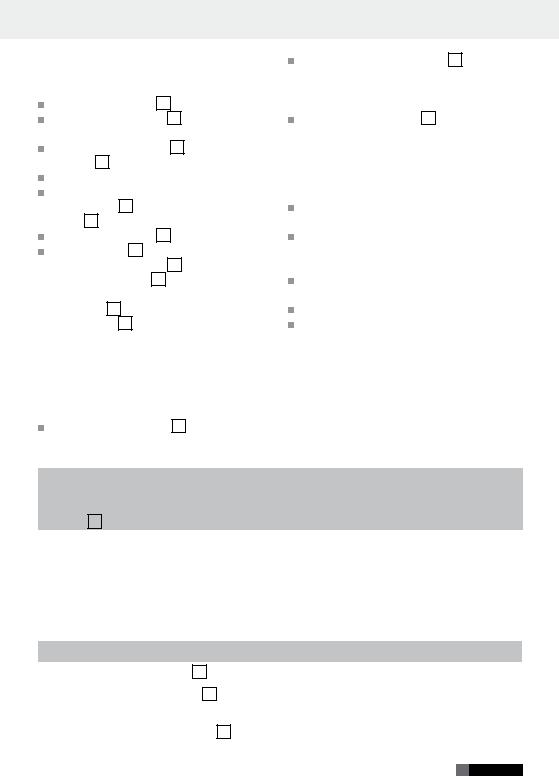
Operation
|
|
Q Inserting or replacing |
Set the rotational speed control |
|
to a position |
||||||||||||||||||||||||||||||||||||
|
1 |
||||||||||||||||||||||||||||||||||||||||
|
|
|
a tool / collet |
|
|
|
|
|
|
|
|
|
|
|
between „1“ and „MAX.“. |
||||||||||||||||||||||||||
|
|
|
Press the spindle lock |
|
|
|
|
and keep it pressed. |
Switching off: |
|
|
|
|
|
|||||||||||||||||||||||||||
|
|
|
8 |
|
|
|
|
|
|
||||||||||||||||||||||||||||||||
|
|
|
Rotate the clamping nut |
|
|
|
until the lock |
Set the On / Off switch |
|
to position “0”. |
|||||||||||||||||||||||||||||||
|
|
|
|
6 |
5 |
||||||||||||||||||||||||||||||||||||
|
|
|
engages. |
|
|
|
|
|
|
|
|
|
|
|
|
|
|
|
|
|
|
|
|
|
|
|
|
|
|||||||||||||
|
|
|
Loosen the clamping nut |
6 |
|
with the combina- |
Q Advice on working with |
||||||||||||||||||||||||||||||||||
|
|
|
tion key |
23 |
. |
|
|
|
|
|
|
|
|
|
|
|
|
|
|
|
|
|
|
|
|
|
|
|
|
||||||||||||
|
|
|
If a tool is already inserted, remove it. |
materials / Tools / Speed ranges |
|||||||||||||||||||||||||||||||||||||
|
|
|
First insert the tool you wish to use through the |
|
|
|
|
|
|
|
|||||||||||||||||||||||||||||||
|
|
|
clamping nut |
6 |
|
|
|
before you insert it into the |
Use the highest speed when working on steel |
||||||||||||||||||||||||||||||||
|
|
|
collet |
18 |
suitable for the tool shaft. |
or iron with the milling bits. |
|||||||||||||||||||||||||||||||||||
|
|
|
Press the spindle lock |
|
|
|
and keep it pressed. |
Use a short trial on a test piece to determine the |
|||||||||||||||||||||||||||||||||
|
|
|
8 |
||||||||||||||||||||||||||||||||||||||
|
|
|
Insert the collet |
18 |
|
into the threaded insert and |
optimum rotational speed range for working on |
||||||||||||||||||||||||||||||||||
|
|
|
tighten the clamping nut |
6 |
on the thread using |
zinc, zinc alloy, aluminium, copper and lead. |
|||||||||||||||||||||||||||||||||||
|
|
|
the combination key |
23 |
. |
|
|
|
|
|
|
|
|
|
|
|
Use the low speed range for working on plastics |
||||||||||||||||||||||||
|
|
|
Note: Use the screwdriver end of the combi- |
and low-melting point materials. |
|||||||||||||||||||||||||||||||||||||
|
|
|
nation key |
23 |
to release or tighten the screw of |
Use high speeds on wood. |
|||||||||||||||||||||||||||||||||||
|
|
|
the mandrels |
|
|
. |
|
|
|
|
|
|
|
|
|
|
|
|
|
|
|
|
|
|
Use the medium speed range for cleaning, |
||||||||||||||||
|
|
|
13 |
|
|
|
|
|
|
|
|
|
|
|
|
|
|
|
|
|
|
||||||||||||||||||||
|
|
|
|
|
|
|
|
|
|
|
|
|
|
|
|
|
|
|
|
|
|
|
|
|
|
|
|
|
|
|
|
|
|
|
polishing and buffing. |
||||||
|
|
Q Switching on and off / Setting |
The following information shall be considered as |
||||||||||||||||||||||||||||||||||||||
|
|
|
the speed range |
|
|
|
|
|
|
|
|
|
|
|
recommendatory only. Learn by practical experience |
||||||||||||||||||||||||||
|
|
|
|
|
|
|
|
|
|
|
|
|
|
|
|
|
|
|
|
|
|
|
|
|
|
|
|
|
|
|
|
|
|
|
which tools and settings are the best for the materi- |
||||||
|
|
Switching on / Setting the speed range: |
als you work with. |
|
|
|
|
|
|||||||||||||||||||||||||||||||||
|
|
|
Set the On / Off switch |
|
5 |
|
to position “I”. |
|
|
|
|
|
|
|
|||||||||||||||||||||||||||
|
|
Setting the appropriate speed |
|
|
|
|
|
|
|
||||||||||||||||||||||||||||||||
|
|
|
|
|
|
|
|
|
|
|
|
|
|
|
|
|
|
|
|
|
|
||||||||||||||||||||
|
|
Symbols |
|
Material |
|
|
|
|
|
|
|
|
|||||||||||||||||||||||||||||
|
|
Rotational |
|
|
|
|
|
|
|
|
|
|
|
|
|
|
|
|
|
|
|
|
|
|
|
|
|
|
|||||||||||||
|
|
speed |
|
|
|
|
|
|
|
|
|
|
|
|
|
|
|
|
|
|
|
|
|
|
|
|
|
|
|||||||||||||
|
|
control |
1 |
|
|
|
|
|
|
|
|
|
|
|
|
|
|
|
|
|
|
|
|
|
|
|
|
|
|
|
|
||||||||||
|
|
|
|
|
|
|
|
|
|
|
|
|
|
|
|
|
|
|
|
|
|
|
|
|
|
|
|
|
|
|
|
|
|
|
|
|
|
|
|
|
|
|
|
1–3 |
|
|
Plastics and low melting |
|
6–7 |
|
Hardwood |
||||||||||||||||||||||||||||||||
|
|
|
|
|
|
|
|
|
|
|
|
|
|
|
|
|
point materials |
|
|
|
|
|
|
|
|
||||||||||||||||
|
|
4–5 |
|
|
Stone, Ceramics |
|
Max |
|
Steel |
||||||||||||||||||||||||||||||||
|
|
|
|
|
|
|
|
|
|
|
|
|
|
|
|
|
|
|
|
|
|
|
|
|
|
|
|
|
|
|
|||||||||||
|
|
5 |
|
|
|
|
|
|
|
|
|
|
|
|
|
Softwood, metal |
|
|
|
|
|
|
|
|
|||||||||||||||||
|
|
|
|
|
|
|
|
|
|
|
|
|
|
|
|
|
|
|
|
|
|||||||||||||||||||||
|
|
Examples of appropriate tool selection Function |
|
|
|
|
|
||||||||||||||||||||||||||||||||||
|
|
|
|
|
|
|
|
|
|
|
|
|
|
|
|
|
|
||||||||||||||||||||||||
|
|
Function |
|
|
Accessory |
Application |
|
|
|
|
|
||||||||||||||||||||||||||||||
|
|
|
|
|
|
|
|
|
|
|
|
|
|||||||||||||||||||||||||||||
|
|
Drilling |
|
|
HSS drill |
|
|
|
|
|
|
Drilling wood (see Fig. C) |
|||||||||||||||||||||||||||||
|
|
|
|
12 |
|||||||||||||||||||||||||||||||||||||
|
|
|
|
|
|
|
|
|
|
|
|
|
|
|
|
|
|
|
|
|
|
|
|
|
|
|
|
|
|
|
|
|
|
|
|
|
|
|
|
|
|
|
|
Milling |
|
|
Milling bits |
|
|
|
|
Various tasks, e.g. hollowing out, gouging, |
|||||||||||||||||||||||||||||||
|
|
|
|
21 |
|||||||||||||||||||||||||||||||||||||
|
|
|
|
|
|
|
|
|
|
|
|
|
|
|
|
|
|
|
|
|
|
|
|
|
|
|
|
|
|
|
|
|
|
|
shaping, grooving or slotting |
||||||
|
|
|
|
|
|
|
|
|
|
|
|
|
|||||||||||||||||||||||||||||
|
|
Engraving |
|
|
Engraving bits |
|
|
Markings (see Fig. D) |
|||||||||||||||||||||||||||||||||
|
|
|
|
20 |
|||||||||||||||||||||||||||||||||||||
|
|
|
|
|
|
|
|
|
|
|
|
|
|
|
|
|
|
|
|
|
|
|
|
|
|
|
|
|
|
|
|
|
|
|
|
|
|
|
|
|
|
|
|
|
|
|
|
|
|
|
|
|
|
|
|
|
|
|
|
|
|
|
|
|
|
|
|
|
|
|
|
|
|
|
|
|
|
|
|
|
|
|
|
|
14 |
GB |
|
|
|
|
|
|
|
|
|
|
|
|
|
|
|
|
|
|
|
|
|
|
|
|
|
||||||||||||||
|
|
|
|
|
|
|
|
|
|
|
|
|
|
|
|
|
|
|
|
|
|
|
|
|
|
|
|
|
|
|
|
|
|
|
|
|
|
|
|
|
|

Operation / Maintenance and cleaning / Service / Warranty
Function |
Accessory |
Application |
|||||||||||
|
|
|
|
|
|
|
|
|
|
|
|
|
|
Polishing, |
Metal brush |
|
|
|
|
|
|
|
|
|
|
|
Derusting (see Fig. E) |
16 |
|||||||||||||
derusting |
|
|
|
|
|
|
|
|
|
|
|
|
|
Polishing wheel |
|
|
|
|
|
Working on various metals and plastics, in |
|||||||
14 |
|
|
|||||||||||
|
|
|
|||||||||||
Caution! |
|
|
|
|
|
|
|
|
|
|
|
|
particular noble metals like gold or silver |
|
|
|
|
|
|
|
|
|
|
|
|
(see Fig. F) |
|
Use only the lightest |
|
|
|
|
|
|
|
|
|
|
|
|
|
|
|
|
|
|
|
|
|
|
|
|
|
|
|
contact pressure of |
|
|
|
|
|
|
|
|
|
|
|
|
|
the tool on the work- |
|
|
|
|
|
|
|
|
|
|
|
|
|
piece. |
|
|
|
|
|
|
|
|
|
|
|
|
|
|
|
|
|
|
|
|
|
|
|
|
|
|
|
Cleaning |
Plastic brush |
|
|
|
|
|
|
|
E.g. cleaning complex plastic housings or the |
||||
19 |
|||||||||||||
|
|
|
|
|
|
|
|
|
|
|
|
|
area around a door lock |
|
|
|
|
|
|
|
|
|
|
|
|
|
|
|
Metal brush |
|
|
|
|
|
|
|
|
e.g. derusting (see Fig. E) |
|||
|
16 |
||||||||||||
|
|
|
|
|
|
|
|
|
|
|
|
|
(The metal brush is softer than steel) |
|
|
|
|
|
|
|
|
|
|
|
|
|
|
Grinding |
Grinding wheels |
|
, |
Grinding of stone, precise tasks on hard materials, |
|||||||||
15 |
|||||||||||||
|
grinding bits |
22 |
|
|
such as ceramics or alloy steel (see Fig. G) |
||||||||
|
|
|
|
|
|
|
|
|
|
|
|
|
|
Cutting |
Cutting discs |
|
|
Cutting metal, plastic (see Fig. H) |
|||||||||
17 |
|||||||||||||
|
|
|
|
|
|
|
|
|
|
|
|
|
|
Q Tips and tricks
If you use press too hard you run the risk of breaking the tool or damaging the workpiece. You will achieve the best results by operating the tool at a constant rotational speed and using a low contact pressure on the workpiece.
original manufacturer parts only. This will ensure that your device remains safe to use.

 If the plug or lead needs to be replaced, always have the replacement carried out by the manufacturer or its service centre. This will ensure that your device remains safe to use.
If the plug or lead needs to be replaced, always have the replacement carried out by the manufacturer or its service centre. This will ensure that your device remains safe to use.
QMaintenance and cleaning
QMaintenance
Before and after a prolonged period of non-use fully charge the battery pack 3a.
Q Cleaning
Clean all the dirt off the drill / grinder. Use a dry cloth for cleaning.
Q Service

 Have your device repaired at the service centre or by qualified specialist personnel using
Have your device repaired at the service centre or by qualified specialist personnel using
Q Warranty
The warranty for this appliance is for 3 years from the date of purchase. The appliance has been manufactured with care and meticulously examined before delivery. Please retain your receipt as proof of purchase. In the event of a warranty claim, please make contact by telephone with our Service Department. Only in this way can a post-free despatch for your goods be assured.
The warranty covers only claims for material and maufacturing defects, but not for transport damage, for wearing parts or for damage to fragile components, e.g. buttons or batteries. This product is for private use only and is not intended for commercial use.
GB 15
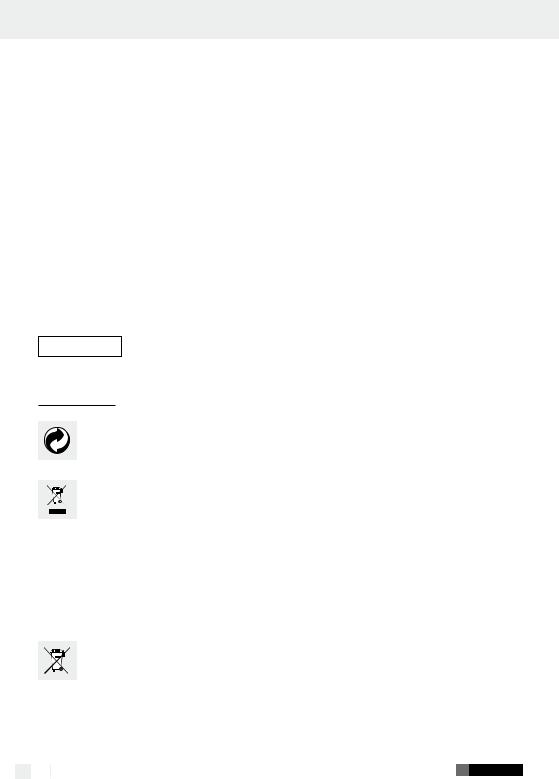
Warranty / Disposal
The warranty is void in the case of abusive and improper handling, use of force and internal tampering not carried out by our authorized service branch. Your statutory rights are not restricted in any way by this warranty.
The warranty period will not be extended by repairs made unter warranty. This applies also to replaced and repaired parts. Any damage and defects extant on purchase must be reported immediately after unpacking the appliance, at the latest, two days after the purchase date. Repairs made after the expiration of the warranty period are subject to payment.
GB
Service Great Britain Tel.: 0871 5000 720
(0,10 GBP/Min.) e-mail: kompernass@lidl.co.uk
IAN 90550
Q Disposal
The packaging comprises exclusively en- vironmentally-friendly material. Dispose of it in your local recycling containers.
Do not dispose of electrical appliances with your domestic waste!
According to the European Directive 2002 / 96 / EC, concerning used electrical and electronic appliances and its implementation in national law, superannuated electrical appliances must be collected and disposed of via an environmentally suitable recycling facility.
Do not dispose of rechargeable batteries with your household refuse!
Defective or worn out rechargeable batteries must be recycled according to Directive 2006 / 66 / EC. Dispose of batteries and appliances over the existing collection facilities.
16 GB
Your local communal or municipal authorities can provide information on how to dispose of the worn out appliance.

Declaration of conformity / Manufacturer
Declaration of conformity / Manufacturer 

We, KompernaSS HANDELS GmbH, the person responsible for documents: Mr Semi Uguzlu, Burg strASSE 21, 44867 Bochum, Germany, hereby declare that this product complies with the following standards, normative documents and EU directives:
Machinery Directive (2006 / 42 / EC)
EU Low Voltage Directive (2006 / 95 / EC)
Electromagnetic Compatibility (2004 / 108 / EC)
RoHS Directive (2011 / 65 / EU)
Applicable harmonized standards
EN 60745-1/A11:2010 EN 60745-2-1:2010 EN 60745-2-3:2011 EN 55014-1/A1:2009 EN 55014-2/A2:2008
EN 60335-2-29:2004+A2:10 EN 62233:2008
EN 60335-1:2002+A11, A1:04+A12, A2:06+A13:08+A14:10+A15:11
EN 61000-3-2:2006/A2:2009 EN 61000-3-3:2008
Type / Appliance Designation:
Cordless multigrinder PFBS 9.6 A1
Date of manufacture (DOM): 06–2013 Serial number: IAN 90550
Bochum, 30.06.2013
Semi Uguzlu
- Quality Manager -
We reserve the right to make technical modifications in the course of further development.
GB 17

18

Kazalo
Uvod |
|
|
Uporaba v skladu z določili............................................................................................................... |
Stran |
20 |
Oprema............................................................................................................................................... |
Stran 20 |
|
Obseg dobave................................................................................................................................... |
Stran 20 |
|
Tehnični podatki.................................................................................................................................. |
Stran |
20 |
Splošna varnostna navodila za električno orodje |
|
|
1. Varnost na delovnem mestu.......................................................................................................... |
Stran 21 |
|
2. Električna varnost........................................................................................................................... |
Stran |
21 |
3. Varnost oseb................................................................................................................................... |
Stran |
22 |
4. Skrbno ravnanje in uporaba električnega orodja........................................................................ |
Stran |
22 |
5. Uporaba akumulatorskega orodja in ravnanje z njim................................................................. |
Stran |
23 |
6. Servis............................................................................................................................................... |
Stran |
23 |
Varnostna opozorila za vse vrste uporabe....................................................................................... |
Stran |
23 |
Povratni udarec in ustrezna varnostna opozorila............................................................................. |
Stran |
24 |
Posebna varnostna opozorila za brušenje in ločevanje.................................................................. |
Stran |
25 |
Dodatna posebna varnostna opozorila za ločevanje..................................................................... |
Stran 26 |
|
Posebna varnostna opozorila za brušenje s smirkovim papirjem................................................... |
Stran |
26 |
Posebna varnostna opozorila za poliranje....................................................................................... |
Stran |
26 |
Posebna varnostna opozorila za delo z žičnimi ščetkami............................................................... |
Stran |
26 |
Varnostna navodila, specifična za napravo za multi brusilnike...................................................... |
Stran |
26 |
Upravljanje |
|
|
Polnjenje akumulatorja....................................................................................................................... |
Stran |
27 |
Vstavljanje akumulatorja v napravo / odstranjevanje akumulatorja iz naprave............................ |
Stran |
27 |
Odčitavanje stanja akumulatorja...................................................................................................... |
Stran |
28 |
Uporaba / zamenjava orodja / zateznih klešč................................................................................. |
Stran |
28 |
Vklop / Izklop / Nastavitev števila vrtljajev........................................................................................ |
Stran |
28 |
Navodila za obdelovanje materiala / Orodje / Nastavitev števila vrtljajev................................... |
Stran |
28 |
Nasveti in triki..................................................................................................................................... |
Stran |
29 |
Vzdrževanje in čiščenje |
|
|
Vzdrževanje........................................................................................................................................ |
Stran 29 |
|
Čiščenje............................................................................................................................................... |
Stran |
29 |
Servis.................................................................................................................................................. |
Stran 29 |
|
Garancija........................................................................................................................................ |
Stran 29 |
|
Odstranjevanje.......................................................................................................................... |
Stran 30 |
|
Izjava o skladnosti / Izdelovalec................................................................................ |
Stran 30 |
|
Garancijski list............................................................................................................................ |
Stran 32 |
|
SI 19
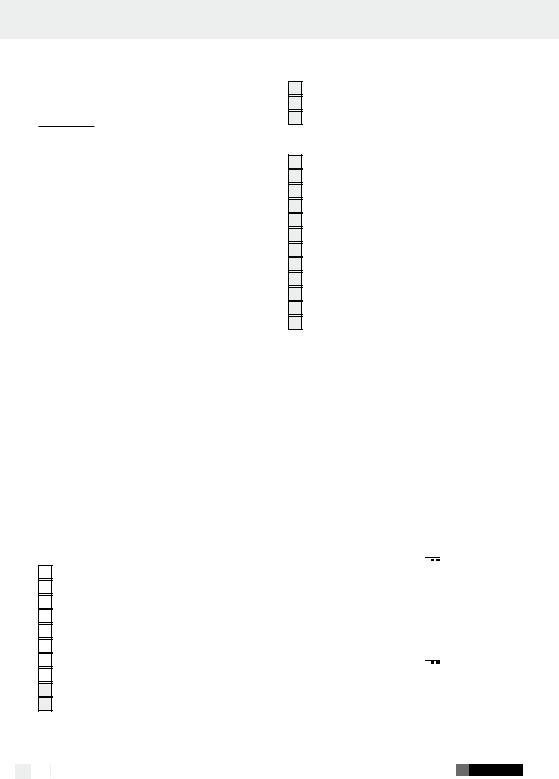
Uvod
Akumulatorski brusilnik in vrtalnik za finomehaniko PFBS 9.6 A1
Q Uvod
Iskrene čestitke ob nakupu vaše nove naprave. Odločili ste se za zelo kakovosten izdelek. To navodilo za uporabo je sestavni del tega izdelka. Vsebuje pomembna navodila za varnost, uporabo in odstranitev. Preden začnete izdelek uporabljati, se seznanite z vsemi navodili za uporabo in varnostnimi napotki. Izdelek uporabljajte samo tako, kot je opisano, in samo za navedena področja uporabe. Če izdelek odstopite novemu lastniku, mu zraven izročite tudi vse dokumente.
Q Uporaba v skladu z določili
Večnamenski brusni stroj se z ustrezno opremo (kot je dobavljena) uporablja za vrtanje, rezkanje, graviranje, poliranje, čiščenje, brušenje, rezanje in žaganje lesa, kovine, plastike, keramike ali kamna v suhih prostorih. Kakršnakoli drugačna uporaba ali sprememba naprave ni v skladu z določili in predstavlja znatno nevarnost nesreč. Za škodo, nastalo pri uporabi, ki ni v skladu z določili, izdelovalec ne prevzame jamstva. Naprava ni namenjena za profesionalno uporabo.
Oprema za polnjenje akumulatorja (glejte sl. A):
9 Polnilnik
10Naprava za priključitev na omrežje
11LED
Oprema (glejte sl. B):
126 HSS Svedrov
132 Nastavka za vpenjanje orodja
143 Polirne ploščice
154 Brusilne ploščice
161 Kovinska ščetka
1716 Ločilnih ploščic
185 Vpenjalne klešče
192 Plastični ščetki
203 Bita za graviranje
212 Biti za rezkanje
225 Bitov za brušenje
23Kombinirani ključ
Q Obseg dobave
1 Akumulatorski brusilnik in vrtalnik za finomehaniko z akumulatorjem
1 Polnilnik
1 Naprava za priključitev na omrežje
1 Komplet opreme (50 delov)
1 Navodilo za uporabo
Q |
Oprema |
Q Tehnični podatki |
|
Akumulatorski brusilnik in vrtalnik za |
Model PFBS 9.6 A1: |
|
|
finomehaniko: |
Nazivna napetost: |
9.6 V |
|
1 |
Regulator števila vrtljajev |
Število vrtljajev: |
n 5000–25000 min-1 |
2 |
LED akumulatorja |
Max. ø ploščic: |
25 mm |
3 |
Tipka za sprostitev akumulatorja |
Območje vpenjanja |
|
3a |
Akumulator |
vpenjalne glave: |
največ ø 3,2 mm |
4 |
Kovinsko obešalo |
|
|
4a |
zapestna zanka |
Akumulator PFBS 9.6 A1-1: |
|
5 |
Stikalo za VKLOP / IZKLOP |
Nazivna napetost: |
9.6 V |
|
Natezna matica |
Kapaciteta: |
1000 mAh NiMH |
6 |
|||
7Prekrivna matica
8Gumb za aretiranje vretena
20 SI

Uvod / Splošna varnostna navodila za električno orodje
Oprema za polnjenje akumulatorja
PFBS 9.6 A1-2: |
|
Primarna: |
|
Nazivna napetost: |
230–240 V , 50 Hz |
nazivna moč: |
13 W |
Sekundarna: |
|
Nazivna napetost: |
12 V |
Polnilni tok: |
400 mA |
Trajanje polnjenja: |
ca. 3 ure |
Zaščitni razred: |
II / |
Informacija o hrupu / vibracijah:
Izmerjena vrednost za hrup določena v skladu z EN 60745. Raven hrupa električnega orodja po A-vrednotenju tipično znaša:
Nivo zvočnega tlaka: |
70,4 dB(A) |
Nivo hrupa: |
81,4 dB(A) |
Negotovost K: |
3 dB |
Uporabljajte zaščitne glušnike!
Ocenjeni pospešek, tipično:
Vibracije na dlani in roki: 0,759 m / s2
Negotovost K = 1,5 m / s2

 Nivo nihanja, ki je naveden v teh navodilih, je bil merjen skladno z merilnim postopkom, normiranim po standardu EN 60745 in se ga lahko uporablja za primerjavo naprav. Navedeno vrednost emisije nihanja lahko uporabite tudi za uvodno ocene izpostavitve.
Nivo nihanja, ki je naveden v teh navodilih, je bil merjen skladno z merilnim postopkom, normiranim po standardu EN 60745 in se ga lahko uporablja za primerjavo naprav. Navedeno vrednost emisije nihanja lahko uporabite tudi za uvodno ocene izpostavitve.
Nivo nihanja se bo spreminjal skladno z uporabo električnega orodja in lahko v nekaterih primerih leži nad vrednostjo, navedeno v teh navodilih. Kadar se električno orodje redno uporablja na tak način, bi nihajno obremenitev lahko podcenili.
Opozorilo: Za natančno oceno nihajne obremenitve med določenim delovnim obdobjem je treba upoštevati tudi čase, v katerih je naprava izklopljena in sicer teče, vendar pa ni dejansko v uporabi. To lahko nihajno obremenitev preko celotnega časov- -nega obdobja občutno zmanjša.
Splošna varnostna navodila za električno orodje

 Preberite varnostna opozorila in navodila!
Preberite varnostna opozorila in navodila!
Neupoštevanje varnostnih opozoril in navodil lahko vodi do povzročitve električnega udara, požara in / ali hudih poškodb.
Vsa varnostna opozorila in navodila shranite za uporabo v prihodnje!
V varnostnih navodilih uporabljeni pojem »električno orodje« se nanaša na električno orodje na omrežni pogon (s kablom za priključitev na omrežje) in na električno orodje na akumulatorski pogon (brez kabla za priključitev na omrežje).
1. Varnost na delovnem mestu
a)Delovno območje naj bo vedno čisto in dobro osvetljeno. Nered in neosvetljena delovna področja so lahko vzrok za nezgode.
b)Z orodjem ne delajte v okolici, kjer obstaja nevarnost eksplozije in v kateri se nahajajo vnetljive tekočine, plini ali prah. Električna orodja proizvajajo iskrice, ki bi lahko povzročile vžig prahu ali pare.
c)Poskrbite, da bodo otroci in druge osebe med uporabo električnega orodja dovolj oddaljene od mesta uporabe.
Če vaša pozornost ni v celoti usmerjena na delo, lahko izgubite nadzor nad orodjem.
2. Električna varnost
a)Priključni vtič električnega orodja (oz. napajalnika) mora ustrezati električni vtičnici. Vtiča v nobenem primeru ne smete spreminjati. Skupaj z ozemljenimi stroji ne uporabljajte dodatnih nastavkov vtiča. Originalen nespremenjen vtič in ustrezna vtičnica zmanjšata tveganje električnega udara.
b)Preprečite telesni stik z ozemljenimi površinami, kot so cevi, grelci, štedil-
SI 21

Splošna varnostna navodila za električno orodje
niki in hladilniki. Obstaja povečano tveganje električnega udara, če je vaše telo ozemljeno.
c)Preprečite stik orodja z vodo ali vlago.
Vdor vode v električno orodje poveča tveganje električnega udara.
d)Kabla ne uporabljajte za nošenje orodja, za obešanje orodja ali za vlečenje vtiča iz vtičnice. Kabel zavarujte pred vročino, olji, ostrimi robovi ali gibljivim delom orodja. Poškodovani ali zavozlani kabli povečajo tveganje električnega udara.
e)Kadar z električnim orodjem delate na prostem, uporabljajte samo električne podaljške, ki so primerni in namenjeni uporabi na prostem. Uporaba električnega podaljška, ki je izdelan za uporabo na prostem, zmanjša tveganje električnega udara.
f)Če se uporabi električnega orodja v vlažnem okolju ne da izogniti, uporabljajte zaščitno stikalo za okvarni tok.
Uporaba zaščitnega stikala za okvarni tok zmanjša tveganje električnega udara.
d)Pred vklopom orodja odstranite vsa orodja, ki jih potrebujete za nastavitve in vse vijačne ključe. Orodje ali ključ v vrtečem se delu orodja bi lahko povzročil poškodbe.
e)Izogibajte se abnormalni telesni drži. Skrbite za varno stojišče in pazite na ravnotežje. Na ta način lahko napravo, še posebno v nepričakovanih situacijah, bolje kontrolirate.
f)Oblečeni bodite v primerna oblačila. Ne nosite širokih oblačil ali nakita. Poskrbite, da v bližino vrtečih se delov stroja ne pridejo lasje, oblačila in rokavice. Ohlapna oblačila, nakit ali dolgi lasje bi se lahko ujeli v premikajoče se dele.
g)Kadar je vgrajena oprema za odsesavanje ali prestrezanje prahu, se prepričajte, da je oprema priključena in pravilno uporabljena. Uporaba opreme zmanjša ogrožanje zaradi prahu.
3. Varnost oseb
a)Ves čas bodite pozorni, pazite, kaj delate in pri delu z električnim orodjem ravnajte razumno. Orodja ne uporabljajte, če ste utrujeni ali če ste pod vplivom droge, alkohola ali zdravil.
Trenutek nepozornosti med uporabo orodja lahko povzroči resne poškodbe.
b)Vedno uporabljajte osebno zaščitno opremo in vedno zaščitna očala. Uporaba osebne zaščitne opreme kot so maska za prah, delovni čevlji z zaščito proti drsenju, zaščitna čelada ali zaščita sluha, odvisno od načina uporabe električnega orodja, zmanjšuje tveganje nastanka poškodb.
c)Preprečite nenameren vklop naprave. Prepričajte se, ali je električno orodje izklopljeno, preden ga priključite na napajanje in / ali akumulator, ga dvignete ali nosite. Če imate pri nošenju naprave prst na stikalu za VKLOP / IZKLOP ali je naprava vklopljena, to lahko vodi do povzročitve nesreč.
22 SI
4.Skrbno ravnanje in uporaba električnega orodja
a)Naprave ne preobremenjujte. Za vaše delo uporabljajte za to namenjeno električno orodje. Z ustreznim električnim orodjem boste v določenem območju zmogljivosti delali bolje in bolj varno.
b)Ne uporabljajte električnega orodja, čigar stikalo je defektno. Električno orodje, ki se ne da več vklopiti ali izklopiti, je nevarno in ga je treba dati v popravilo.
c)Preden izvajate nastavitve na napravi, zamenjujete dele opreme ali napravo daste iz rok, izvlecite električni vtič iz vtičnice in / ali odstranite akumulator.
Ti previdnosti ukrepi preprečujejo nenameren zagon električnega orodja.
d)Neuporabljano električno orodje hranite zunaj dosega otrok. Osebam, ki z napravo niso seznanjene ali niso prebrale teh navodil, uporabe naprave ne dovolite. Električno orodje je nevarno, če ga uporabljajo neizkušene osebe.
